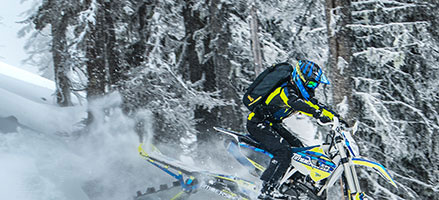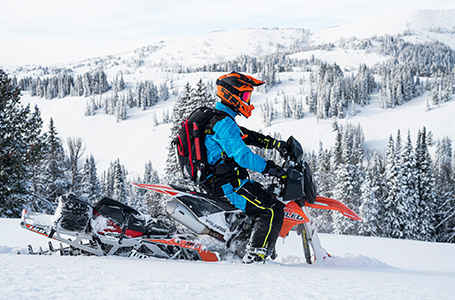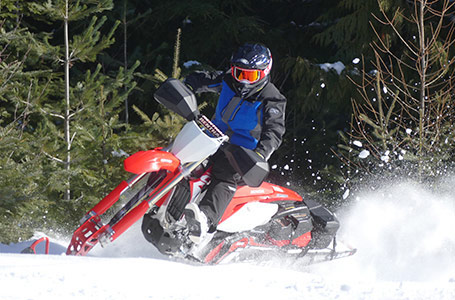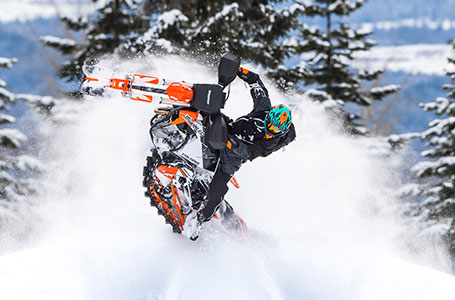
What Is A Snow Bike And How Are They So Awesome?
The snowmobile's little brother is poised to seize the slopes.The bike is narrow, but stable enough that I can easily rest my feet on the pegs and balance without moving. The first time I give it some gas, I stall. On a second try, as I get to the end of a straightaway, I struggle to turn and nearly run over my instructor. But by lap number three, I’m in third gear, spraying snow as I carve around turns, and hooting like an idiot. How had I never tried this before?
You’d be forgiven if you’ve never heard of snow bikes until now, but that won’t last long. After languishing in big brother snowmobile’s shadow, snow bikes are finally having their moment. Basically just dirt bikes with a tank-like tread system replacing the rear wheel and a ski replacing the front wheel, they are smaller, more nimble, and a lot cheaper than snowmobiles. It’s a combo of features that makes them poised to become the dominant motorized snow machine for pure recreation. It also helps that they’re a whole lot of fun, even for first-timers.
If there’s one main barrier to entry, it’s that this is something of a DIY job for now. If you want to buy a snow bike, what you’ll really be getting is a conversion kit that turns your standard dirt bike into a snow machine. These kits are made by a variety of companies and when you buy one you also get mounting hardware for your specific dirt bike, be it Honda, Yamaha, Kawasaki, or what have you. As long as your dirt bike was born in the 90s or later, there’s a good chance you can find a kit. Conversion will take a little bit of work, but it offers a huge added bonus: can ride your dirt bike all summer, then, when the snow starts coming down, you swap in the track and ski and can keep riding all winter. Once the snow melts you just swap the wheels back in.
“Terrific,” you might say. “I’ve always wanted a snowmobile!” Think again. These are completely different beasts. Snow bikes, unlike their broader and heavier cousins, are narrow, light, and much easier to turn, which lets you to go where snowmobiles simply can’t, cutting your own lines through dense trees. Snowmobiles are notoriously lousy for side-sloping (sliding sideways instead of going forward cutting across a steep slope). On a snow bike, because you’re on just one ski and one tread, you remain upright like you would if you were mountain biking. The setup also enables you to carve your way down very steep terrain, as if you were on a snowboard.
All that said, words do not quite suffice as a means of describing what these machines are capable of. As a visual aid, I suggest you watch this:
The concept of the snow bike is far from new. Prototypes for motorcycles with two rear wheels that could accommodate tracks go as far back as the 1920s. In WWII, both France and Germany got into the game, attempting to make a lean machine that could be used for warfare in the rough terrain and snow of the Alps. In the 1930s, the American company J.E. Love developed the Shrew snow cycle, which was the first snow bike that had a ski in the front on shocks. They made between 500 and 1000 Shrews but they had some problems with overheating engines. They were also extremely difficult to turn but very easy to tip.
That was about as close to success as snow bikes came for a while, though there were many iterations by many manufacturers through the 1950s and 60s. Popular Mechanics even featured a kit from a company called “Snow Job” in 1973, but the unit was wide and awkward, especially considering its $778 pricetag, which is more than $4,300 adjusted for inflation. There was a similar failure in 1977 when the U.S. military commissioned Chrysler to develop what would be called the Sno-Runner. Ultimately the government decided to pass on it because it would get stuck in deep snow, so Chrysler went public with it in 1979. It was advertised as a “light utility mountain vehicle” and it was showed off at ski resorts around the country. They were sold for $900 and never found a market, so they were pulled by 1982.
But today, after a few more decades of technological advancement, these nimble snow machines are flying off the shelves, building an ever-growing tribe of devotees, and even showing up on the biggest stages in snow sports. While a handful of companies now make snow bikes, the basic design has mostly stabilized. They all have a ski up front and a track in the rear with roughly 20 inches of suspension travel, giving the bikes a very cushy feel even on uneven terrain. Companies like Moto Trax, Yeti Snow MX, Sno Ripper, and CMX all have followings, but the 800-pound gorilla in the market, and the one most responsible for the snow bike renaissance, is the Idaho-based company Timbersled which revitalized the age-old design.
Until Timbersled, the front ski on snow bikes were essentially just a ski that was pulled off of a snowmobile, a piece of kit perhaps unsurprisingly ill-suited for transplant onto a much smaller, lighter vehicle. Rather than having a flat bottom, Timbersled’s snow-biking ski has three well-defined keels, each with two carving edges on them. There’s a large, center keel which is essentially what you’re balancing on when you’re going straight in hardpacked snow. Then, crucially, there are the two shorter keels on each side, which give you another set of edges you can use to carve along a side-slope. The channels in between the keels also afford the bike far greater flotation. This was a major game changer. Suddenly the ski could float through powder. It could handle cliff-drops without the nose digging in, sending you over the handlebars. It gave riders an incredible amount of control at a wide range of speeds and essentially let you carve like you were on a motorized snowboard. At ESPN’s inaugural Winter X Games Snow BikeCross competition—a 30 lap race around a track with bumps, jumps, and hairpin turns—a whopping 13 of the 16 athletes chose to ride Timbersleds.
And I can understand why after riding one for myself at a press event. Even as green as could be, with no motorcycle or dirt bike experience to speak of, I was up and cruising in mere minutes. The trickiest part was learning to turn, which requires you to lean in and really commit in order to engage the side of the bike’s skis. But within five minutes I was having more fun than I’d ever had on a snowmobile. I loved the dexterity the bike had, and how it was so easy to carve whatever line I wanted. It may not have the sheer uphill climbing power that a snowmobile has, with its higher horsepower engine and bigger, toothier track, but the bike more than made up for those deficiencies with its effortlessness.
That’s actually a large part of the appeal of snow bikes. Because they weigh so much less than a snowmobile, that means that smaller, lighter riders don’t have to exhaust themselves wrestling a bulky machine through turns. Even kids can make the bike more or less goes where they want it to by just leaning. Add in the ability to take it into steep terrain with dense trees and suddenly a lot more of the backcountry is open to you. You don’t need to worry as much about following a trail when your bike is fine with powder and can carve fine on its own.
Timbersled, which is now owned by Polaris, claims it has doubled the number of sleds it sold every year since 2010, which would bring their numbers to between 5,000 and 10,000 per year, currently, and that’s just one company. At this rate snow bikes are easily on pace to outsell snowmobiles in the next few years, and it’s not hard to see why. Rather than buy a snowmobile that will sit in your garage eight months out of the year, these conversion kits enable you to ride a motor bike year-round and really have a blast in any conditions. Personally, I can’t wait to get some more time on one this coming winter.
By: Brent Rose
https://www.popularmechanics.com/adventure/outdoors/a13974686/the-snow-bikes-are-coming/










Share this Story